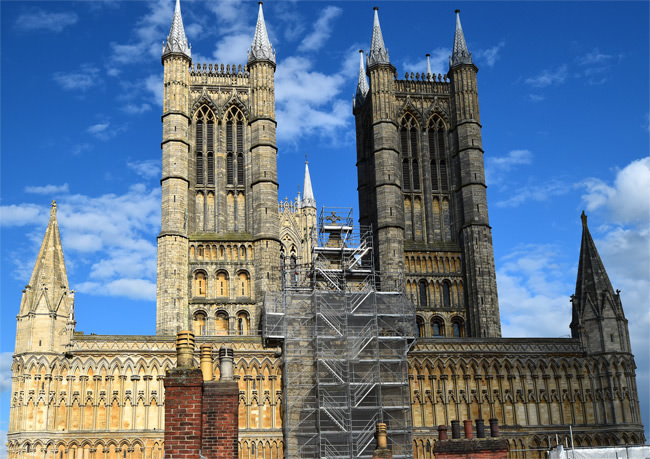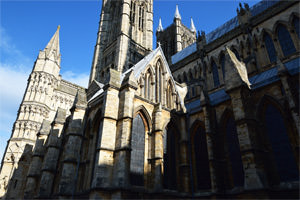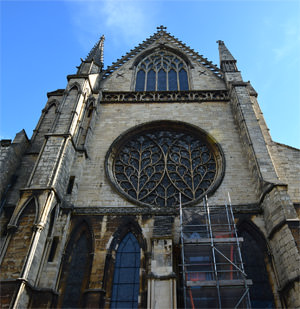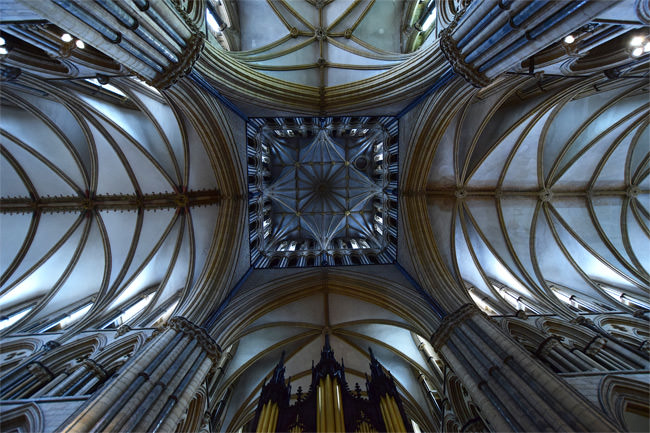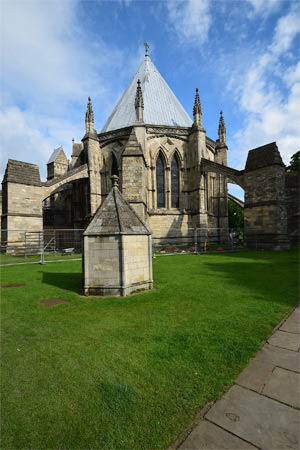Lincoln’s majestic cathedral dominates the surrounding plain from its spectacular perch atop Lincoln Cliff. Its bulk - already planted 50 metres above the surrounding plain - soars skywards a further 83 metres. Seen in almost any weather, the cathedral exerts an irresistible pull on one’s attention. Its towers are luminous against brooding storm clouds, dazzling against blue skies and its west front burns bronze at the day’s end. Given that it has for decades been surrounded by coal-fired power stations and heavy industry, the current programme of restoration and cleaning (see the scaffolding in these photographs) will surely do wonders for the place.
It is also a building through which the accumulation of time and history is capable of dumbfounding us. When just twenty years young, its roof was destroyed by fire. When less than a hundred years young, it was split from top to bottom by a magnitude 5 earthquake. For nearly 200 years the building was probably the tallest construction on earth, surpassing the Great Pyramid of Giza until in 1548 a storm blew down the spire that sat atop the central tower. Had that remained, the cathedral’s lofty presence would have reached 160 metres into the sky.
It bears some of these scars today. Climb up inside one of the west towers and traverse their connecting walkway to get a close view of the central arch and the bosses of the nave’s own vault, and the misalignment of some 30 cms can’t be missed. Where rebuilding of both sections was undertaken, the meeting point was out of skew and remains permanently beyond correction. (Jump to the photograph of this idiosyncrasy, below.)
(The asymmetrical crazy vaulting above St. Hugh’s Choir is considered in detail below.)
There are too many wonders in Lincoln Cathedral for a single web page, yet several cannot escape mention. My favourite has to be the asymmetrical crazy vaulting above part of St. Hugh’s Choir. Lincoln’s vaulting was introduced after the fire of 1141, a rare thing in mid-twelfth century England. Longitudinal and transverse ridge ribs, intersected with diagonal ribs, provide a framework into which stone vaulting can be added, curving downwards to meet the rising verticals of nave and aisle walls. This should be sufficiently dramatic. At Lincoln, this design is embellished with the introduction of tiercerons whose purpose is entirely decorative. Imagine a rectangle formed by two transverse ridge ribs. The roof ridge bisects this and two bosses sit one-third of the way along this section of the vault. These bosses attract three tiercerons from each wall, the outer ends of which connect to the corners of the rectangle. But the arrangement is asymmetrical - and all the better for it.

Not only did this mark a strong departure from tradition, it results in a design that is skew-whiff. Rather than connecting to the roof’s apex at a single boss on the centre of the ridge, these tiercerons scissor off to connect to two points on the ridge. There’s nothing wrong with the geometry - or with the structural integrity of the vault. It possesses an elegance and a new dynamism that is unique to Lincoln.
Cathedrals are some of the best examples of places where the bonds of community leave a lasting mark, shown by solemn memorial, jubilant celebration and playful jest alike. Lincoln’s cathedral is no exception. The Jubilee Crown fixed in 2012 to the the base of St Hugh’s pinnacle, commissioned jointly by the Friends of Lincoln Cathedral and Lincolnshire County Council, is one example. The almost hidden carving that commemorates the end of fox hunting in England, dated 18.2.2005, on a capital on the west front is another. Both follow the Lincoln Imp, the mischievous grotesque carved by medieval stonemasons and fixed high up in the cathedral’s stone forest, cherished and retold down the ages.

